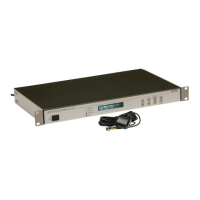56 Timing, IRIG-B and Pulses
For important considerations about IRIG-B connections, distribution of signals and accuracy, down-
load the file,
IRIG-B accuracy and connection requirements.pdf at the following link:
http://arbiter.com/resources/documentation.php and select Timing and Frequency, then select Ap-
plication Notes/Option Information.
7.4.3 Synchronizing Multiple IED’s From One Masterclock Output
In many installations, master clock signals are “fanned out” to a number of devices. This method
makes more efficient use of the clock synchronizing capability since the clock drivers are designed
to handle multiple loads. The exact number of possible loads must be determined from the input
impedance of each connected IED. For example, if the input impedance of the IED is 5 kilohms,
determine the device current (I) as follows:
(7.1) I = V ÷ R
dev
= 5 V olts ÷ 5000 Ohms = 0.001 Amps (1 mA)
If you were to connect ten of the same IED’s to the same output, then the total current drawn
would be 10 x 0.001 A = 0.01 A (10 mA).
7.4.4 Connecting Unmodulated IRIG-B
To drive multiple loads from one unmodulated IRIG-B output, make sure that the loads are wired
in parallel. Some technicians might call this “daisy-chaining”, however the idea is to drive all of
these loads in parallel from the single output. It is much simpler to connect loads to unmodulated
IRIG-B than for modulated, because all of the loads are driven at the same voltage.
To determine load current for one Unmodulated IRIG-B output:
1. determine the number of loads to be connected to a single clock output
2. determine the impedance (or resistance) of each load
3. calculate the load current for each device (I
dev
= 5V ÷ R
dev
)
4. sum up all the load currents for the total current for one clock output.
Another method is to determine the lumped impedance of all of the connected IED’s in parallel.
Then, determine the overall current by dividing the drive voltage (5 V) by the computed lumped
impedance value. This current should not exceed 75 mA.
7.4.5 Connecting Modulated IRIG-B
The total load capacity for the modulated IRIG-B driver depends on the type and number of loads.
The main difference in computing the load capacity for modulated IRIG-B and unmodulated IRIG-
B is that most of the modulated IRIG-B decoders are fairly sensitive to the peak-to-peak voltage.
When adding loads, the clock’s modulated driver produces more current, which is passes through
the internal source resister, dropping the available output voltage. The open circuit voltage (i.e.
with no loads) is approximately 4.5 Vpp, so any connected loads will cause the available voltage to
drop. It is a simple task to compute the available output voltage (Vpp) with a known current.
(7.2) V pp = 4.5 V pp − I × 19.6 Ohms

